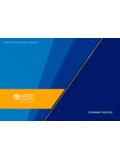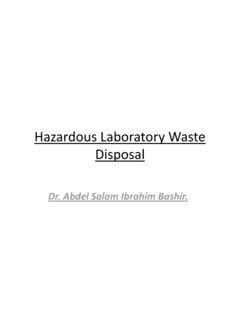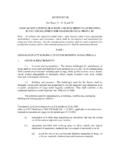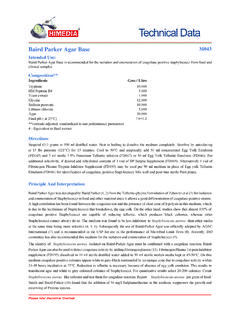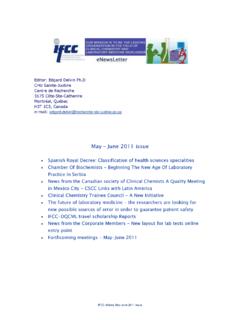Transcription of Exclusion of Objectionable Microorganisms from …
1 Exclusion of Objectionable Microorganisms from Non-Sterile Pharmaceuticals, Medical Devices and Cosmetics Tony Cundell, Ph. D. Microbiological Consultant, Scarsdale, New York September, 2015 1 bioMerieux Customer Meeting Presentation Overview Introduction to the PDA Technical Report on the Exclusion of Objectionable Microorganisms from non-sterile drug products. Regulatory definition of Objectionable Microorganisms . The role of microbial testing in detecting Objectionable Microorganisms Decision trees for Objectionable organisms in different dosage forms Review of clinical literature, product recalls and infection outbreaks Conclusions September, 2015 bioMerieux Customer Meeting 2 PDA Technical Report As the result of the work of a broad-based industry task force, PDA TR No.
2 67 Exclusion of Objectionable Microorganisms from Non-Sterile Pharmaceuticals, Medical Devices and Cosmetics published October, 2014 in conjunction with the PDA Global Pharmaceutical Microbiology Conference, Bethesda, Maryland. September, 2015 3 bioMerieux Customer Meeting Other Notable Publications USP <1115> Bioburden Control in Non-sterile Drug Substances and Drug Products that emphasizes the frequency of monitoring should reflect the potential risk associated with the dosage form was published in Second Supplement to USP 37 official on December 1, 2014. September, 2015 bioMerieux Customer Meeting 4 Technical Report The objective of the technical report was to define industry best practices on how to mitigate the risk of microbial contamination in non-sterile products Emphasis on: Risk-based decision criteria Assessing whether Microorganisms if found in a non-sterile product were Objectionable or not.
3 No list of Objectionable Microorganisms was provided September, 2015 5 bioMerieux Customer Meeting Task Force Members Anil Sawant, J&J (Co-chair) Tony Cundell, Consultant (Co-chair) Donald G. Ahearn, Georgia State University Matthew Arduino, CDC Julie Barlasov, Perritt Laboratories Mark Dato, MD, P&G Andrew Dick, J&J Donald English, Avon Rhonda Ezell, Qualitest Pharmaceuticals Dennis Guilfoyle, FDA David Hussong, , FDA Mark Kaiser, Lancaster Laboratories Michael Long, Consultant Patrick Murray, Ph. D. Becton Dickson Judith Noble-Wang, CDC Per Arne Parment, MD. Consultant Dona Reber, Pfizer David Roesti, Novartis Frank Settineri, Consultant Linda Skowronsky, GlaxoSmithKline Donald Singer, GlaxoSmithKline John Stone, Kao, USA Scott Sutton, Consultant Edward Tisdale, Baxter Myriam Sosa, Novartis September, 2015 6 bioMerieux Customer Meeting Scope of the Task Force The contamination of marketed products with potential Objectionable Microorganisms continues to be an infrequent but chronic problem.
4 Around 20 U. S. recalls annually. The , Japanese and European pharmacopeias have harmonized the microbial test methods for enumeration and the detection of specified Microorganisms that would be the basis of testing. Mycotoxins, viruses and sterile dosage forms were out of scope of this Technical Report. September, 2015 7 bioMerieux Customer Meeting US Recalls of Non-sterile Products A recent survey of 144 reported recalls of non-sterile pharmaceutical drug products (5%), over-the-counter drug products (42%), cosmetics (31%), medical devices (14%) and dietary supplements (8% of the total recalls) for microbiologically-related issues for the 7-year period from 2004 through 2011. Publication highlighted that the majority of these recalls (72%) were associated with Objectionable Microorganisms and not for exceeding microbial enumeration limits (Sutton and Jimenez, 2012).
5 September, 2015 8 bioMerieux Customer Meeting Industry Challenge An absence of Objectionable Microorganisms requirement for a non-sterile product is a Critical Quality Attribute without a defined test method and acceptance criteria making it a unique product specification. Furthermore, there is no consensus amongst manufacturers and regulators how to approach this issue. September, 2015 9 bioMerieux Customer Meeting Regulatory Requirements FDA GMPs: The FDA CGMP regulations 21 CFR Control of microbiological contamination states: a) Appropriate written procedures, designed to prevent Objectionable organisms in drug products not required to be sterile, shall be established and followed. Furthermore, 21 CFR Testing and release for distribution (b) states: There shall be appropriate laboratory testing, as necessary, of each batch of drug product required to be free of Objectionable Microorganisms .
6 September, 2015 10 bioMerieux Customer Meeting TGA Requirements ICH Q4B Annex 4 A Microbiological Examination of Non-Sterile Products: Microbial Enumeration Tests (General Test Chapter); Test for Specified Microorganisms (General Test Chapter) and Acceptance Criteria for Pharmaceutical Preparations and Substances for Pharmaceutical Use (General Informational Chapter). Note: These are harmonized with USP <61>, <62> and <1111> September, 2015 bioMerieux Customer Meeting 11 TGA Objectionable Microorganisms In addition to being free from contamination with specified Microorganisms , a non-sterile medicine should also be free from contamination with other Microorganisms that might be Objectionable in the dosage form.
7 For example, pseudomonad-type bacteria are considered to be Objectionable in aqueous dosage forms that are intended for inhalant, cutaneous, nasal, auricular, oromucosal, gingival or vaginal use and in transdermal patches. These dosage forms are expected to be free from contamination with these types of bacteria. September, 2015 bioMerieux Customer Meeting 12 TGA Recommendations Evaluation of the significance of, and risk from, other Objectionable Microorganisms should consider: the formulation of the medicine its route of administration its method of application the population for which the medicine is intended, including: the possibility of underlying illness in the user of the medicine the possible concurrent use of immunosuppressive agents or corticosteroids.
8 September, 2015 bioMerieux Customer Meeting 13 What are Objectionable Microorganisms ? CGMP regulations, CFR does not define the term Objectionable Microorganisms , but they can be broadly defined as: 1) Microorganisms that can proliferate in a product adversely affecting the chemical, physical, functional and therapeutic attributes of that pharmaceutical product. 2) Microorganisms that due to their numbers in the product and their pathogenicity can cause infection in the patient in the route of administration when treated with that pharmaceutical product. September, 2015 14 bioMerieux Customer Meeting Microbiological Testing Product-release and shelf-life testing Three levels of testing are required: 1) microbial enumeration, 2) testing for the absence of specified Microorganisms , and 3) screening for Objectionable Microorganisms .
9 September, 2015 15 bioMerieux Customer Meeting Regulatory Requirements The inclusion of the phrase "as necessary in many regulations implies a risk-based approach to product testing and decisions about which products will or will not be routinely tested. Drug manufacturers cannot rely solely on finished product testing to comply with regulation but must ensure the quality of their products from the receipt of production materials to the end of the manufacturing process by following current GMPs. September, 2015 16 bioMerieux Customer Meeting Regulatory Requirements Bioburden control is achieved by: Procuring pharmaceutical ingredients of high microbiological quality. Formulating robust products with low water activities and effective preservative systems that resist microbial contamination.
10 Good bioburden control through sound equipment cleaning, disinfectant programs, utility management and personnel hygiene. Emphasis on cGMP compliance. Risk-based microbial testing programs. September, 2015 17 bioMerieux Customer Meeting Recommended Microbiological Quality Requirements The recommended microbiological quality requirements by pharmaceutical dosage form can be found in the harmonized general informational chapter USP <1111> Microbiological attributes of non-sterile pharmaceutical products. Specific microbial requirement may be found in individual USP product monographs. September, 2015 bioMerieux Customer Meeting 18 Microbiological Quality Requirements Dosage Form TAMC TCYMC Absence of Specified Microorganisms (in 1 g or 1 mL) Non-aqueous preparations for oral use ( , tablets and capsules) 103 102 E.

